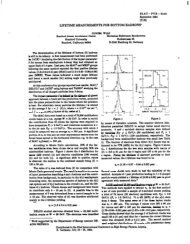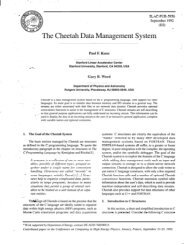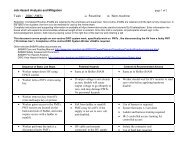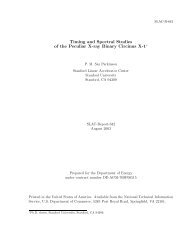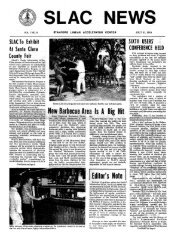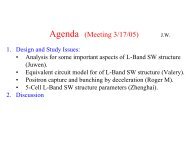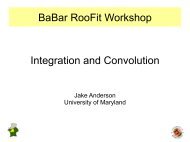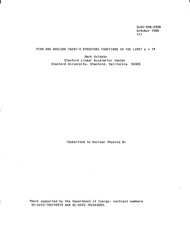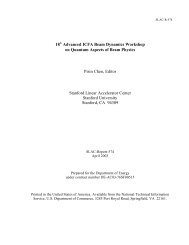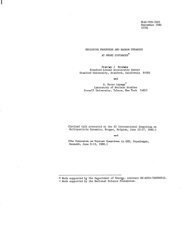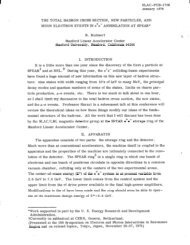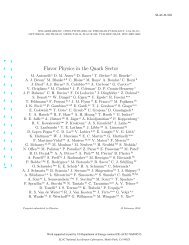The Use and Calibration of the Kern ME5000 Mekometer - SLAC ...
The Use and Calibration of the Kern ME5000 Mekometer - SLAC ...
The Use and Calibration of the Kern ME5000 Mekometer - SLAC ...
You also want an ePaper? Increase the reach of your titles
YUMPU automatically turns print PDFs into web optimized ePapers that Google loves.
--<br />
Variance Component Analysis<br />
measurements be input in a specific order. <strong>The</strong> instrument station which is used to<br />
measure to all o<strong>the</strong>r target stations has to be <strong>the</strong> first data set. For each instrument station<br />
<strong>the</strong> distance measurements have to be input in ascending order.<br />
<strong>The</strong> output file shows <strong>the</strong> date <strong>and</strong> time when <strong>the</strong> data was processed, which input file<br />
was used, <strong>the</strong> header line <strong>of</strong> <strong>the</strong> input file <strong>and</strong> indicates if <strong>the</strong> calculations where done with<br />
or without <strong>the</strong> addition constant It also shows <strong>the</strong> number <strong>of</strong> baseline monuments, <strong>the</strong><br />
value for <strong>the</strong> exponent H used <strong>and</strong> <strong>the</strong> start values for a, <strong>and</strong> %. <strong>The</strong> next section<br />
contains <strong>the</strong> results after n iterations starting with <strong>the</strong> mean square error a postetiori, <strong>the</strong><br />
variance components 012 , CJ,~ <strong>and</strong> <strong>the</strong>ir estimated variances, <strong>the</strong> adjusted distances with<br />
<strong>the</strong>ir r.m.s., <strong>and</strong> <strong>the</strong>’ addition constant if calculated. <strong>The</strong> variable SO represents <strong>the</strong><br />
approximate distance <strong>and</strong> dS <strong>the</strong> addition to obtain <strong>the</strong> adjusted distance. Finally, <strong>the</strong> last<br />
section contains each measured distance with its residual <strong>and</strong> <strong>the</strong> estimated mean square<br />
error M(s) according to equation (2-4). <strong>The</strong> weights ~/M(s)~ are also calculated.<br />
2.3. Extensions to <strong>the</strong> ma<strong>the</strong>matical <strong>and</strong> stochastic model<br />
<strong>The</strong> previous section describes all <strong>the</strong> unknowns <strong>and</strong> variance components which are<br />
calculated by <strong>the</strong> program VARCOM used at <strong>SLAC</strong> for <strong>the</strong> analysis <strong>of</strong> baseline<br />
measurements. In a more recent paper Koch [7] exp<strong>and</strong>ed <strong>the</strong> ma<strong>the</strong>matical <strong>and</strong> stochastic<br />
model to include <strong>the</strong> case <strong>of</strong> distance dependent addition constants <strong>and</strong> cyclic errors which<br />
can be determined if absolute distances are known. It also deals with <strong>the</strong> situation in which<br />
an instrument with superior accuracy is used as reference for an instrument with inferior<br />
accuracy. <strong>The</strong> ma<strong>the</strong>matical model (2-l) can be exp<strong>and</strong>ed as follows:<br />
~1; - xlj + C + K = dg + r with (2-15)<br />
C=c,+cld,+czd;+od: <strong>and</strong> (2-16)<br />
K = kll cos@> + k12 cos(2p) + kzl sin + k~ sin (2P) <strong>and</strong><br />
(2-17)<br />
mod(du,F)<br />
p=27t F (2-18)<br />
Equation (2-16) represents in polynomial form <strong>the</strong> distance-dependent addition constant<br />
C <strong>of</strong> <strong>the</strong> instrument to be calibrated. Equation (2-17) shows <strong>the</strong> frost terms <strong>of</strong> a Fourier<br />
polynomial to describe <strong>the</strong> cyclic phase error K. <strong>The</strong> unknowns c0 through c3 <strong>and</strong> k,,<br />
through k22 <strong>of</strong> <strong>the</strong> instrument to be calibrated are summarized in <strong>the</strong> vector <strong>of</strong> unknowns xc,<br />
while <strong>the</strong> unknowns <strong>of</strong> <strong>the</strong> superior instrument are summarized in <strong>the</strong> vector xs Likewise<br />
<strong>the</strong> matrix <strong>of</strong> coefficients is split into a section containing <strong>the</strong> coefficients <strong>of</strong> <strong>the</strong> instrument<br />
to be calibrated <strong>and</strong> a section containing <strong>the</strong> coefficients <strong>of</strong> <strong>the</strong> instrument which is used as<br />
reference. <strong>The</strong>refore <strong>the</strong> following observation equations in matrix form can be derived.<br />
44



